Compensatory signals associated with the activation of human GC 5' splice sites
- PMID: 21609956
- PMCID: PMC3167603
- DOI: 10.1093/nar/gkr306
Compensatory signals associated with the activation of human GC 5' splice sites
Abstract
GC 5' splice sites (5'ss) are present in ∼1% of human introns, but factors promoting their efficient selection are poorly understood. Here, we describe a case of X-linked agammaglobulinemia resulting from a GC 5'ss activated by a mutation in BTK intron 3. This GC 5'ss was intrinsically weak, yet it was selected in >90% primary transcripts in the presence of a strong and intact natural GT counterpart. We show that efficient selection of this GC 5'ss required a high density of GAA/CAA-containing splicing enhancers in the exonized segment and was promoted by SR proteins 9G8, Tra2β and SC35. The GC 5'ss was efficiently inhibited by splice-switching oligonucleotides targeting either the GC 5'ss itself or the enhancer. Comprehensive analysis of natural GC-AG introns and previously reported pathogenic GC 5'ss showed that their efficient activation was facilitated by higher densities of splicing enhancers and lower densities of silencers than their GT 5'ss equivalents. Removal of the GC-AG introns was promoted to a minor extent by the splice-site strength of adjacent exons and inhibited by flanking Alu repeats, with the first downstream Alus located on average at a longer distance from the GC 5'ss than other transposable elements. These results provide new insights into the splicing code that governs selection of noncanonical splice sites.
Figures

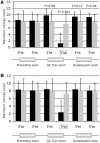
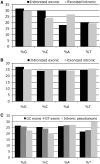

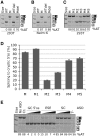

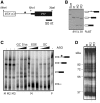
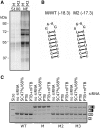
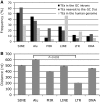
Similar articles
-
Regulation of a strong F9 cryptic 5'ss by intrinsic elements and by combination of tailored U1snRNAs with antisense oligonucleotides.Hum Mol Genet. 2015 Sep 1;24(17):4809-16. doi: 10.1093/hmg/ddv205. Epub 2015 Jun 10. Hum Mol Genet. 2015. PMID: 26063760 Free PMC article.
-
Profiling of cis- and trans-acting factors supporting noncanonical splice site activation.RNA Biol. 2021 Jan;18(1):118-130. doi: 10.1080/15476286.2020.1798111. Epub 2020 Aug 5. RNA Biol. 2021. PMID: 32693676 Free PMC article.
-
Ranking noncanonical 5' splice site usage by genome-wide RNA-seq analysis and splicing reporter assays.Genome Res. 2018 Dec;28(12):1826-1840. doi: 10.1101/gr.235861.118. Epub 2018 Oct 24. Genome Res. 2018. PMID: 30355602 Free PMC article.
-
Pick one, but be quick: 5' splice sites and the problems of too many choices.Genes Dev. 2013 Jan 15;27(2):129-44. doi: 10.1101/gad.209759.112. Genes Dev. 2013. PMID: 23348838 Free PMC article. Review.
-
Recognition of the 5' splice site by the spliceosome.Acta Biochim Pol. 1998;45(4):869-81. Acta Biochim Pol. 1998. PMID: 10397335 Review.
Cited by
-
The role of short RNA loops in recognition of a single-hairpin exon derived from a mammalian-wide interspersed repeat.RNA Biol. 2015;12(1):54-69. doi: 10.1080/15476286.2015.1017207. RNA Biol. 2015. PMID: 25826413 Free PMC article.
-
Splice-correction strategies for treatment of X-linked agammaglobulinemia.Curr Allergy Asthma Rep. 2015 Mar;15(3):510. doi: 10.1007/s11882-014-0510-0. Curr Allergy Asthma Rep. 2015. PMID: 25638286 Free PMC article. Review.
-
The cyclin-dependent kinase G group defines a thermo-sensitive alternative splicing circuit modulating the expression of Arabidopsis ATU2AF65A.Plant J. 2018 Jun;94(6):1010-1022. doi: 10.1111/tpj.13914. Epub 2018 May 10. Plant J. 2018. PMID: 29602264 Free PMC article.
-
CYCLIN-DEPENDENT KINASE G1 is associated with the spliceosome to regulate CALLOSE SYNTHASE5 splicing and pollen wall formation in Arabidopsis.Plant Cell. 2013 Feb;25(2):637-48. doi: 10.1105/tpc.112.107896. Epub 2013 Feb 12. Plant Cell. 2013. PMID: 23404887 Free PMC article.
-
Transposon clusters as substrates for aberrant splice-site activation.RNA Biol. 2021 Mar;18(3):354-367. doi: 10.1080/15476286.2020.1805909. Epub 2020 Sep 23. RNA Biol. 2021. PMID: 32965162 Free PMC article.
References
-
- Wahl MC, Will CL, Lührmann R. The spliceosome: design principles of a dynamic RNP machine. Cell. 2009;136:701–718. - PubMed
-
- Burge CB, Tuschl T, Sharp PA. In: The RNA World. Gesteland RF, Cech TR, Atkins JF, editors. New York: Cold Spring Harbor Laboratory Press; 1999. pp. 525–560.
Publication types
MeSH terms
Substances
Supplementary concepts
LinkOut - more resources
Full Text Sources
Other Literature Sources
Research Materials
Miscellaneous

